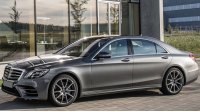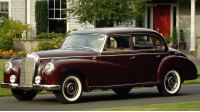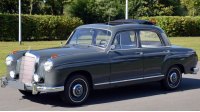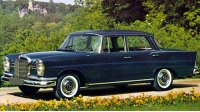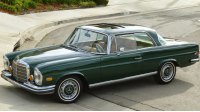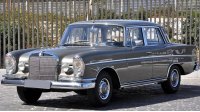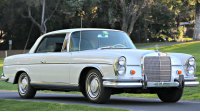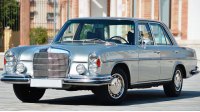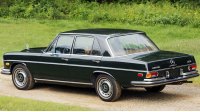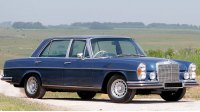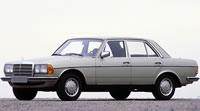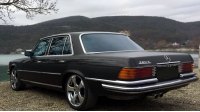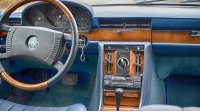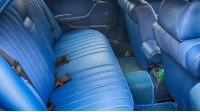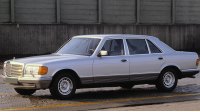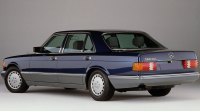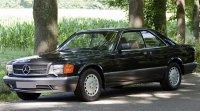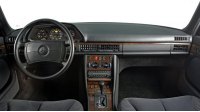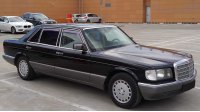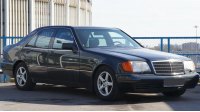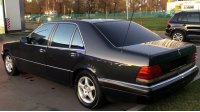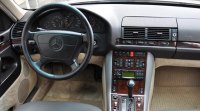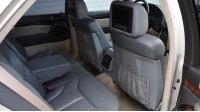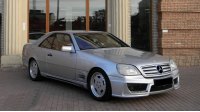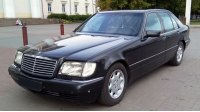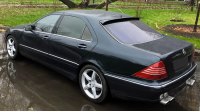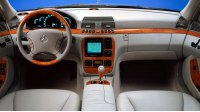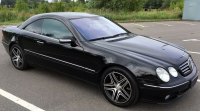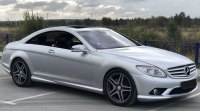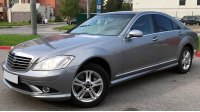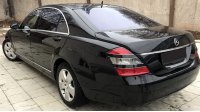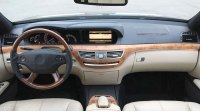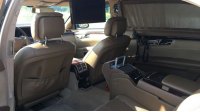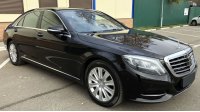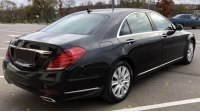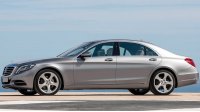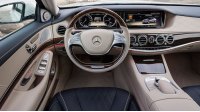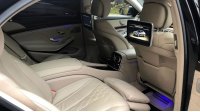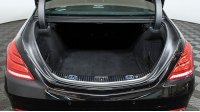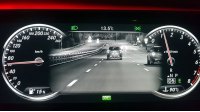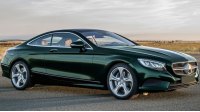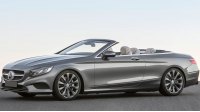Is the best-selling car in the world in its segment (F). The main competitors of the S-class today are Audi A8, BMW 7, Jaguar XJ, Cadillac XTS, Genesis G90, Infiniti Q70, Kia Quoris, Lexus LS, Porsche Panamera and Volkswagen Phaeton.
Predecessors of the S-Class
W187 (1951−1955)
The production of luxury cars in the post-war period, Mercedes-Benz began in 1951. «W187» was presented at the International Motor Show in Frankfurt in April. The car was equipped with a gasoline six-cylinder engine with a single overhead camshaft of 2.2 liters (2195 cm3, M180) 80 hp, which worked in conjunction with a 4-speed manual transmission. The body was a sedan, coupe and convertible. Body length was 4507 mm, height 1685 mm. In total, more than 18 thousand cars were produced.
W186 (1951−1957)
In the same year, the production of an even larger car with the code «W186», also called «Type 300». Body length was 4950 mm, width 1840 mm. Body styles were 4-door sedan, limousine, convertible and phaeton. The engine was installed gasoline 3-liter (2996 cm3, M186) with six cylinders in-line with a capacity of 115 hp. The transmission was a 4-speed manual and a 3-speed automatic. In total, more than 12 thousand cars were produced.
W180 (1954−1959)
In March 1954, a car was introduced with the code «W180». It was a completely new body shape, unofficially called «Pontoon». First generation «220a» produced until 1956. 2.2 liter six-cylinder in-line engine (2195 cm3, M180) 80 hp Second generation «220S» produced since March 1956. Visually distinguished by a new front bumper, chrome strips under the doors. The engine is still the same, but it was modified and the power was increased to 99 and 105 hp. Body styles were 4-door sedan, as well as 2-door coupe and convertible. Body length was 4715-4760 mm, width 1740-1765 mm, height 1530-1560 mm. For five years, about 85 thousand cars were produced.
W105 (1956−1959)
Another representative of the luxury car family «Pontoon» with official name «Typ 219». The body was in the form of a 4-door sedan with a length of 4680 mm, a width of 1740 mm, a height of 1560 mm and a curb weight of 1260 kg. Under the hood was a 2.2-liter six-cylinder in-line engine (2195 cm3, M180, I6) with double carburetor «Solex 32», which gave out power of 85 hp. More than 27 thousand cars were produced.
W128 (1958−1960)
Comfortable car with code «W128» and title «220SE» started producing in 1958. This is the last in a series «Pontoon». The body was in the form of a 4-door sedan, 2-door coupe and convertible. The length was 4750 mm, width 1740 mm, height 1560 mm. Gasoline six-cylinder in-line engine with a volume of 2.2 liters (2195 cm3, M127) with overhead camshaft and mechanical fuel injection «Bosch» 115 hp It differed from its predecessors in the use of a body as a supporting structure and a fully independent suspension. A four-speed gearbox was paired with an automatic clutch. For all the time, 3.9 thousand cars were produced.
W111 (1959−1971)
The first Mercedes-Benz car with an unofficial name «Fintail» (fin style). Behind the car, two fins are clearly distinguished at the edges. Production of 4-door sedans began in August 1959. The car was presented at the International Motor Show in Frankfurt in autumn. At first the model names were «220b», «220Sb» And «220SEb». Letter «E» in the name means fuel injection company «Bosch». The body was a 4-door sedan, as well as a 2-door convertible or coupe. Body length was 4875 mm, width 1795 mm, height 1510 mm. The curb weight was 1320 kg. In total, about 370 thousand cars were produced.
The sedans were equipped with a 2.2-liter gasoline six-cylinder in-line engine (2195 cm3, M180) 95 and 105 hp Fuel-injected engines developed 120 hp. Since 1965, sedans have been equipped with a 2.3-liter engine «230 S» (2307 cm3, M127, I6) 120 hp 2.5-liter engines were installed on coupes and convertibles «250 SE» (2496 cm3, M129, I6) 150 hp, 2.8 liters «280 SE» (2778 cm3, M130, I6) 160 hp and 3.5 liters «280 SE 3.5» (3499 cm3, M116, V8) 200 hp
W112 (1961−1967)
Executive car with code «W112» and title «300SE» It was produced with a body of a 4-door sedan, 2-door convertible and coupe. Body design made with the concept «Fintail». The length of the car was 4882 mm, width 1795 mm, height 1460 mm, curb weight 1602 kg. In 1963, an extended wheelbase appeared with the name «300SEL». In total, about 10 thousand cars were produced.
This car is different «W111» bigger body, more expensive trim, more chrome on the outside, nearly double the price, and a more powerful 3.0-liter engine (2996 cm3, M189, I6). This engine has six cylinders in a row, Bosch fuel injection, 160 hp. (170 HP after 1964). The body design is made in the style «Fintail». Standard features «W112» are air suspension, power steering, automatic transmission. The manual also remained and could be chosen as an option.
W108 and W109 (1965−1972)
The fashion for fins is a thing of the past and will be replaced «W111» And «W112» came finless «W108» And «W109». These are the last predecessors of the E-class. They were presented at the International Motor Show in Frankfurt in autumn 1965. The body was only a 4-door sedan. Length «W108» was 4900 mm, width 1810 mm, height 1440 mm and curb weight 1470-1610 mm. Length «W109» was 5000 mm, width 1810 mm, height 1440 mm and curb weight 1655-1830 kg. The frameless monocoque concept has shown good results. About 383 thousand cars were produced (W108: 364k; W109: 18k).
Range of gasoline engines «W108» looked like this - 2.5 liters «250 S» (2497 cm3, M108, I6, carburetor, 128 hp), 2.5 liters «250 SE» (2497 cm3, M129, I6, mechanical injection, 148 hp), 3.0 liters «300 SE» (2996 cm3, M189, I6, mechanical injection, 168 hp), 2.8 liters «280 S» (2778 cm3, M130, I6, carburetor, 138 hp), 2.8 liters «280 SE» / «280 SEL» (2778 cm3, M130, I6, mechanical injection, 158 hp) and 3.5 liters «280 SE 3.5» (3499 cm3, M116, V8, electronic injection, 197 hp). The transmission was a 4-speed manual or automatic.
Model gasoline engines «W109» had the following characteristics - 3.0 liters «300 SEL» (2996 cm3, M189, I6, mechanical injection, 168 hp), 2.8 liters «300 SEL» (2778 cm3, M130, I6, mechanical injection, 168 hp), 3.5 liters «300 SEL» (3499 cm3, M116, V8, electronic injection, 197 hp), 4.5 liters «300 SEL 4.5» (4520 cm3, M117, V8, electronic injection, 195 hp) and 6.3 liters «300 SEL 6.3» (6333 cm3, M100, V8, mechanical injection, 247 hp). Transmission was installed 4-speed manual or automatic 3 and 4-speed.
First generation (W116, 1972−1980)
In 1972, with the advent of the car with the code «W116» also officially named «S-Class». The official show was in September 1972 at the Paris Motor Show. Development began in 1966. The design, developed in 1969 by eminent automotive designer Friedrich Geiger, was a great leap forward. This is the company's first vehicle to offer ABS as an option. The body was only a 4-door sedan with a length of 4960 mm, a width of 1870 mm and a height of 1410 mm. There was a model with an extended wheelbase with an index «SEL» length 5060 mm. In 1974 modification «450 SE» was named European Car of the Year. For the entire period, about 473 thousand cars were produced.
The range of gasoline engines consisted of the following - 2.8 liters «280 S» (2746 cm3, M110, I6, carburetor, 158 hp), 2.8 liters «280 SE» (2746 cm3, M110, I6, injection, 182 hp), 3.5 liters «350 SE» (3499 cm3, M116, V8, injection, 197 hp), 4.5 liters «450 SE» (4520 cm3, M117, V8, injection, 222 hp) and 6.9 liters «450 SEL 6.9» (6834 cm3, M100, V8, injection, 282 hp). The diesel engine was one 3.0 liter «300 SD» (3005 cm3, OM617, I5, 110 and 120 hp). Until 1975, the engines were equipped with D-Jetronic electronic injection, but after that it was replaced with a more reliable mechanical K-Jetronic. Transmission installed 4 and 5-speed mechanics or 3 and 4-speed automatic.
All cars «W116» brought many safety innovations such as ABS (Prevents wheel lock when braking), reinforced body in the area of the passenger cell (high-strength roof and door pillars), crumple zones front and rear, safety interior details (deformable switches and controls, shock absorber steering wheel), air bag for the driver, more protected fuel tank (installed not at the rear end of the car, but above the rear axle), as well as direction indicators for communicating with other drivers.
The most famous of the first generation S-Class is the high-performance version called «450 SEL 6.9». The car is based on a chassis with an extended wheelbase. It was equipped with the largest non-American engine after World War II (for cars). The motor had a volume of 6.9 liters. It was shown for the first time at the Geneva Motor Show in 1974 and until 1981 only 7380 units were produced. It was the flagship of the Mercedes-Benz car line and the successor to the sedan «300 SEL 6.3». Many innovations first appeared on this car, such as ABS, self-levelling hydropneumatic suspension, 3-speed automatic transmission «W3B 050», limited differential «ZF» and also many options for the convenience of the driver and passengers. The price of the car at the time of launch was DM 69,930.
Second generation (W126, 1980−1991)
Second generation development with code «W126» started back in October 1973. The main goal of the engineers was to improve ride comfort, improve handling and improve fuel efficiency. This was necessary to maintain the leadership of the S-class in its segment. The design was developed under the guidance of Italian automotive designer Bruno Sacco. The use of lighter materials and wind tunnel testing of the body allowed for a 10% reduction in fuel consumption. Drag coefficient (C d) the sedan had 0.36, the coupe had 0.34.
In September 1979, the car was shown at the International Motor Show in Frankfurt. At first, only the body of a 4-door sedan was presented. There was a version «SEL» with extended wheelbase. The length of a conventional sedan was 4995-5020 mm, the length of the extended sedan was 5135-5160 mm; width 1820 mm, height 1430-1441 mm. In 1981, a 2-door coupe appeared with the code «C126» 4910-4935 mm long, 1828 mm wide, 1406 mm high. The engine was located in front with rear-wheel drive. Over a 12-year period, about 892 thousand cars were produced.
The range of gasoline engines included the following models - 2.6 liters «260 SE» (2597 cm3, M103, I6, injection, 158 and 164 hp), 2.8 liters «280 S» (2746 cm3, M110, I6, carburettor, 154 hp), 2.8 liters «280 SE» (2746 cm3, M110, I6, injection, 182 hp), 3.0 liters «300 SE» (2960 cm3, M103, I6, injection, 178 and 185 hp), 3.8 liters «380 SE» (3818 cm3, M116, V8, injection, 201 and 215 hp), 4.2 liters «420 SE» (4196 cm3, M116, V8, injection, 201, 215, 221 and 228 hp), 5.0 liters «500 SE» (4973 cm3, M117, V8, injection, 220, 228, 237, 242, 249 and 261 hp) and 5.5 liters «560 SEL» (5547 cm3, M117, V8, injection, 239, 268, 275 and 296 hp). Diesel engines had the following characteristics - 3.0 liters «300 SD» (2996 cm3, OM617, I5, 123 hp), 3.0 liters «300 SDL» (2996 cm3, OM603, I6, 148 hp) and 3.5 liters «350 SD» (3449 cm3, OM603, I6, 134 hp). The gearbox was installed 4 and 5-speed manual or 4-speed automatic «4G-TRONIC».
The most advanced safety and driver assistance systems appeared on this car. In addition to the driver's airbag, a passenger airbag could be fitted as an option from 1986, and side airbags were available from 1988. Traction control system (TCS) or traction control has been available since 1989. There were pretensioners for all seat belts in order to better support the passenger in the event of a situation close to an accident; crumple zones front and rear to absorb impact energy; since 1988 anti-lock braking system (ABS) became mandatory for all modifications; a third brake light in the center of the rear window, and much more.
The S-Class was the most comfortable car in the Mercedes-Benz lineup. The second generation has the following convenience options - fully automatic climate control system with an interior temperature sensor, an outside temperature sensor with an LCD display on the instrument panel, eight-way adjustable front seats with memory, adjustable rear seats, heated all seats in two modes, lighting on the bottom of the doors that illuminates the ground when they are opened, etc.
Third generation (W140, 1991−1998)
At the Geneva Motor Show in April 1991, the new generation S-Class was introduced. Prior to this, in November 1990, the company issued a press release announcing «W140». The body was first in the form of a 4-door sedan with a length of 5111 mm, a width of 1886 mm and a height of 1486 mm. Extended wheel (code «V140») the base made the length of the body 5213 mm. Since October 1992, a 2-door coupe was introduced with the code «C140» 5065 mm long, 1895 mm wide and 1427 mm high. In 1993, there was a change in the names of all cars. letter «E», denoting fuel injection, was removed, since all engines were injected, and the letter «S», denoting the model, began to be placed in front of the numbers indicating the volume of the motor. For example, model «500 SE» became known as «S 500», and the extended body «500 SEL» referred to as «S 500 L». Coupe in 1996 «C140» separated into a separate branch with the name «CL-Class».
Development «W140» started way back in 1981. In 1986, a project was chosen by the French automotive designer Olivier Bouley, who worked under the direction of Bruno Sacco. In 1987, several prototypes were tested. After that, 1.5 years were spent developing ways to accommodate the V12 engine and a new braking system. From June 1990 to January 1991, several experimental models were produced, and from April full-scale production began. It is believed that about $ 1 billion was spent on development. In just 7 years, about 433 thousand cars were produced.
All engines of this generation are equipped with fuel injection and four valves per cylinder. The range of gasoline engines is as follows - 2.8 liters «300 SE 2.8» / «S 280» (2799 cm3, M104, I6, 190 hp), 3.2 liters «300 SE» / «S 320» (3199 cm3, M104, I6, 228 hp), 4.2 liters «400 SE» / «S 420» (4196 cm3, M119, V8, 275 and 282 hp), 5.0 liters «500 SEL» / «S 500» (4973 cm3, M119, V8, 322 hp), and 6.0 liters «600 SEL» / «S 600» (5987 cm3, M120, V12, 389 and 402 hp). There were also high performance motors «AMG» 7.0 liters (V12) 518 hp There were two diesel engines - 3.0 liters «S 300» (2996 cm3, OM606, I6, 175 hp) and 3.5 liters «300 SD» / «S 350» (3449 cm3, OM603, I6, 148 hp). Gearbox 5-speed manual, 4-speed automatic «4G-Tronic» and 5 speed automatic «5G-Tronic».
This generation also brought many innovations such as anti-pinch power windows, dual windows, power trunk lid closing, mechanical rear parking markers (replaced by sonar in 1996), heating system running when the engine is off, rear hydropneumatic suspension, first used on «450 SEL 6.9» in 1975. Electric drives were installed on almost all devices that were extended and raised. The rear seats of sedans with heating, power adjustment and memory are not inferior in comfort to the front ones. The price of the car, due to the many options, has become 25% more expensive than the previous generation, so the level of sales has decreased.
In March 1994, a restyled model was presented at the Geneva Motor Show, which went on sale in April 1994. To help the driver began to install electronic stability control (ESP) as an option, traction control (TCS), brake system «Brake Assist». External changes affected the direction indicators, which became transparent from orange, the rear optics also became a little different, the bumpers began to be painted to match the overall body color, and the ground clearance was also slightly reduced (ground clearance). The interior and electronic systems have also been updated. In 1996, they updated the coupe and brought it to a separate branch «CL-Class».
«W140» introduced several safety innovations that have become the norm for many cars today. This is the braking system «Brake Assist», which regulates the braking force on the wheels; electronic stabilization system (ESP), which does not allow the car to roll over or go into a skid during sharp maneuvers; high-intensity xenon headlights will allow you to see better at night and not blind oncoming drivers; since 1996, side airbags and sensors for the presence of passengers on the seats have been installed; in the same year, rain sensors for windshield wipers appeared.
The car's safety reputation was somewhat compromised by the crash that killed Princess Diana and her two companions. The front passenger survived. The car was «S280». However, the presence of alcohol in the driver's blood, exceeding the speed limit by 2 times the limit in that section, and not using seat belts greatly reduced the car's ability to protect passengers.
Fourth generation (W220, 1998−2005)
Development of the fourth generation began in 1992 under the direction of British car designer Steve Mattin and production began on 13 August 1998. Also in August, at the Paris Motor Show, the car was presented to the public. The body was only a 4-door sedan with a length of 5042 mm, a width of 1855 mm, a height of 1444 mm, a body with an increased wheelbase was 5158 mm long. 2 door coupe with code «C216» was moved to a separate class «CL-Class». The body has become a little smaller, but due to the reduction of the trunk in the cabin, it has become a little more spacious. Drag coefficient (C d) was only 0.27. First all-wheel drive «4Matic» as an alternative to the classic back. In total, about 485 thousand cars were produced.
The range of gasoline engines is the following models - 2.8 liters «S 280» (2799 cm3, M112, V6, 194 hp), 3.2 liters «S 320» (3199 cm3, M112, V6, 221 hp), 3.7 liters «S 350» (3724 cm3, M112, V6, 242 hp), 4.3 liters «S 430» (4296 cm3, M113, V8, 275 hp), 5.0 liters «S 500» (4996 cm3, M113, V8, 302 hp), 5.8 liters «S 600» (5786 cm3, M137, V12, 362 hp) and 5.5 liters «S 600» (5513 cm3, M275, V12, Bi-Turbo, 493 hp). There were also performance cars «AMG» with engines of 5.4 liters «S55» (5439 cm3, M113, V8, 355 and 493 hp), 6.3 liters «S63» (6258 cm3, M137, V12, 438 hp) and 6.0 liters «S65» (5980 cm3, M275, V12, Bi-Turbo, 604 hp). Diesel engines were of the following characteristics - 3.2 liters «S 320» (3222 cm3, OM613 and OM648, I6, 194 and 201 hp) and 4.0 liters «S 400» (3996 cm3, OM628, V8, 247 and 256 hp). Transmissions only automatic 5 and 7-speed «5G-Tronic» And «7G-Tronic».
Traditional flagship car «S-class» carries on board the newest and most advanced technologies in the field of automotive industry - air suspension «Airmatic», active ventilated seats, keyless entry and start, world's first radar and adaptive cruise control that works with it «Distronic», switchable cylinders for models «S 500» And «S 600» to save fuel. Four-wheel drive «4Matic» was introduced in 2003 as an option for models «S 430» And «S 500». Torque is distributed in a ratio of 40/60 (front/rear) with electronic regulation depending on road conditions. For the first time, a side curtain airbag appeared on a Mercedes-Benz.
The vehicle has not passed safety testing by organizations such as Euro NCAP, IIHS and NHTSA. Passive safety features include strong aluminum and steel bulkheads and frames. The front and rear ends of the car are aluminum boxes in the form of separate blocks to reduce the cost of repairs when they are crushed. Collision avoidance system introduced in 2002 «Pre-Safe». Became basic for all trim levels electronic stabilization system (ESP) And «Brake Assist». In total, the car is equipped with eight airbags. Behind installed LED brake lights for all modifications. In 2000, the second generation of voice control was introduced «Linguatronic», understands up to 300 words. The car was also equipped with almost all systems known at that time for passenger comfort and driver assistance.
In September 2002, the model was updated. The exterior changes were very minor, mostly bug fixes in the car's internal functions such as the COMAND music management system, and an updated engine lineup. At the front bumper, the air intakes were changed, the radiator grill became slightly higher.
Fifth generation (W221, 2005−2013)
Fifth generation of the flagship S-Class car with code «W221» was presented at the Frankfurt Motor Show in September 2005. Development began in 1999. In 2001, the project of the German car designer Gorden Wagner was approved, and the final version was shown to journalists in December 2002. The exterior and interior are very different from the previous generation. The dimensions of the car have been increased, which made the interior even more spacious. Until 2009, the length was 5076 mm, width 1871 mm, height 1473 mm. After restyling in 2009, the length became 5079 mm, width 1872 mm, height 1473 mm. The length of the car with an increased wheelbase was 5206 mm and 5209 mm. The engine was located longitudinally in front, rear axle drive or all-wheel drive «4Matic». In total, about 516 thousand cars were produced.
The range of gasoline engines looked like this - 3.0 liters «S 280» / «S 300» (2997 cm3, M272, V6, 228 hp), 3.5 liters «S 350» (3498 cm3, M272, V6, 258 hp), 3.5 liters «S 350» (3498 cm3, M276, V6, 302 hp), 3.5 liters «S 400 HYBRID» (3498 cm3, M272, V6, 275 hp) + (20 hp electric motor), 4.7 liters «S 450» (4663 cm3, V8, M273, 335 hp), 5.5 liters «S 500» / «S 550» (5461 cm3, M273, V8, 383 hp), 4.7 liters «S 500» / «S 550» (4663 cm3, M278, V8, BiTurbo, 429 hp), 5.5 liters «S 600» / «S 600 Guard» (5513 cm3, M275, V12, BiTurbo, 510 hp). There were also tuning models from «AMG» - 6.2 liters «S 63 AMG» (6208 cm3, M156, V8, 518 hp), 5.5 liters «S 63 AMG» (5461 cm3, M157, V8, BiTurbo, 537 hp) and 6.0 liters «S 65 AMG» (5980 cm3, M275, V12, BiTurbo, 604 hp). Diesel engines were of the following characteristics - 2.2 liters «S 250» / «S 300» (2143 cm3, OM651, V6, 201 hp), 3.0 liters «S 300 BlueTec HYBRID» (2987 cm3, OM642, V6, + electric motor, 261 hp), 3.0 liters «S 320» / «S 350» (2987 cm3, OM642, V6, Biturbo, 232 and 237 hp) and 4.0 liters «S 420» / «S 450» (3996 cm3, OM629, V8, Biturbo, 316 hp). Transmission only automatic 5 or 7-speed «5G-Tronic» / «7G-Tronic».
All modifications used air suspension «Airmatic». As an option, you can choose a hydraulic suspension technology «Active Body Control», which allows you to change the clearance of the car with the button and better control the turns. All-wheel drive appeared in 2006 «4Matic».
As always, the car is the most advanced in the field of passenger safety. System «Brake Assist Plus», working in conjunction with the radar, warns the driver of a possible collision, and also slows down the car itself if a collision threatens, and the driver does not take any action.
Safety system «Pre-Safe» predicts a collision and, if likely, tightens seat belts, inflates around the edges of the airbag, closes all windows and sunroof, transforms seats and head restraints to a safe position, reduces speed by braking. To improve manageability, ESP systems were installed in the base (electronic stability control), ASR (traction control) and ABS (anti-lock brakes). Speed limiter «Speedtronic» recognizes road signs and controls the allowed speed on road sections. Cruise control «Radronic Plus» Together with the radar, it monitors the distance to the vehicle in front and can bring your vehicle to a complete stop. Plus eight airbags as standard.
Bi-xenon adaptive headlights allow you to see further at night and not dazzle oncoming drivers. First presented night vision system «Night View Assist», which recognized pedestrians and warned the driver. Driver fatigue recognition system «Attention Assist» warns of the need to rest. There is also a blind spot monitoring system, a car-holding system in its lane, automatic dimming rear-view mirrors and many other useful features to help the driver.
The development of the update began in 2006, and in 2009 this update was carried out. The exterior and interior of the car has changed slightly. New or upgraded driver assistance features, passenger comfort systems and multimedia controls have been added.
Sixth generation (W222, 2014-present)
car with code «W222» began development in 2009, first shown in Hamburg on May 15, 2013, production began in June, and sales started in September 2013. It was presented to the public at the International Motor Show in Frankfurt in September 2013. The design was developed under the direction of Slovenian automotive designer Robert Leshnik. Appearance and interior similar to cars «CLA-class» And «E-class». As of the end of 2016, more than 300 thousand vehicles were produced.
The engine was located transversely in front, rear-wheel drive. In November 2013, four-wheel drive appeared «4Matic». The body of the 4-door sedan was produced with the usual (3035 mm) and elongated (3165 mm) wheelbase. The usual body had a length of 5116 mm, a width of 1899 mm and a height of 1496 mm. The body with an extended wheelbase had a length of 5246 mm. In addition, there was a sedan body created by the division «Mercedes-Maybach» 5453 mm long, as well as a limousine body «Pullman». From this generation, the coupe body, formerly called «CL class» became known again «S-class» with code «C217». At the Frankfurt Motor Show in 2015, a convertible body was presented with a convertible top in the modification «AMG» with internal code «A217». The last convertible «S-class» was released back in 1971 with the code «W112».
The range of gasoline engines is represented by the following modifications - 3.0 liters «S 320 L» (2996 cm3, M276, V6, turbo, 268 hp), 3.0 liters «S 400 L» (2996 cm3, M276, V6, biturbo, 328 hp), 3.5 liters «S 400 HYBRID» (3498 cm3, M276, V6, 302 hp) + (electric motor 27 hp), 4.7 liters «S 500» (4663 cm3, M278, V8, 449 hp), 3.0 liters «S 500 PLUG-IN HYBRID» (2996 cm3, M276, V6, 328 hp) + (electric motor 108 hp) and 6.0 liters «S 600» (5980 cm3, M277, V12, biturbo, 523 hp). There were also two modifications from «AMG» 5.5 liters «S 63 AMG» (5461 cm3, M157, V8, biturbo, 577 hp) and 6.0 liters «S 65 AMG» (5980 cm3, M279, V12, biturbo, 621 hp). Diesel engines were as follows - 2.2 liters «S 300 BlueTec HYBRID» (2148 cm3, OM651, I4, twin turbo, 201 hp) + (electric motor 27 hp) and 3.0 liters «S 350 BlueTec» (2987 cm3, OM642, V6, turbo, 254 hp). Transmission only automatic 7 or 9 speed «7G-Tronic» / «9G-Tronic».
Nine airbags were fitted as standard. The vehicle has six radar sensors (radar) different ranges, as well as two infrared sensors - near and far. There is a stereo video camera in front. Together they scan the surrounding area to detect obstacles such as vehicles or pedestrians. Autonomous cruise control «Distronic Plus» can not only maintain speed depending on the car in front, but also keep the car in the center of its lane, that is, steer. Collision avoidance system «BAS Plus» together with «Cross-Traffic Assist» helps avoid collisions at intersections. The pedestrian collision avoidance system warns the driver of the presence of people and also assists the driver when braking.
Collision avoidance system «Pre-Safe Plus» expanded its functionality. When there is a possibility of a rear impact, the rear lights flash to warn the rear driver. With seat belt system «Pre-Safe Impulse» are pulled away from the direction of impact and pressed deeper into the seats early in the crash. The inflatable seat belt protects the chest in a frontal collision. Adaptive LED headlights illuminate the road much better than conventional headlights and don't blind oncoming drivers, and you don't have to shift from high to low. Only LEDs are used in outdoor and indoor lighting (only about 500 pieces). Third generation night vision system «Night View Assist Plus» with a far infrared sensor, it detects not only pedestrians, but also potentially dangerous animals at a distance of up to 100 meters.
In 2017, the model was restyled, which was presented at the Shanghai Auto Show in April. External changes were minor. Numerous driver assistance systems have been improved, as well as updated engines. The following new gasoline engines have appeared - 3.0 liters «S 450» (2999 cm3, M256, I6, 362 hp), 3.0 liters «S 500» (2999 cm3, M256, I6, 429 hp), 4.0 liters «S 560» (3982 cm3, M176, V8, 463 hp) and 6.0 liters «S 600» (5980 cm3, M277, V12, biturbo, 520 hp). Engines from «AMG» became the next - 4.0 liters «S 63» (3982 cm3, M177, V8, 604 hp) and 6.0 liters «S 65» (5980 cm3, M279, V12, biturbo, 620 hp). A 2.9-liter diesel engine also appeared «S 350 d» / «S 400 d» (2928 cm3, OM656, I6, 282 and 340 hp).

